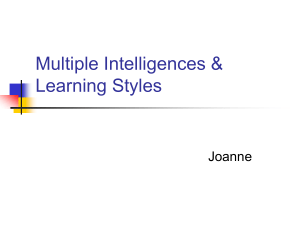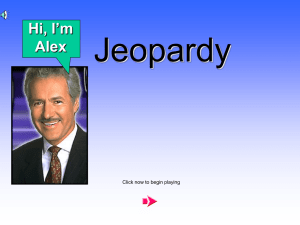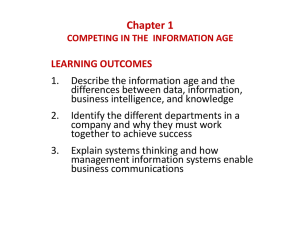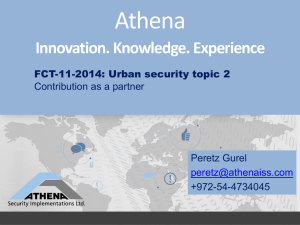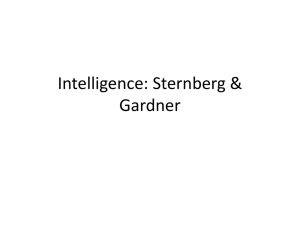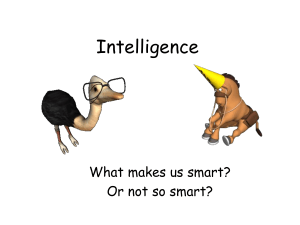Multiple Intelligences
advertisement
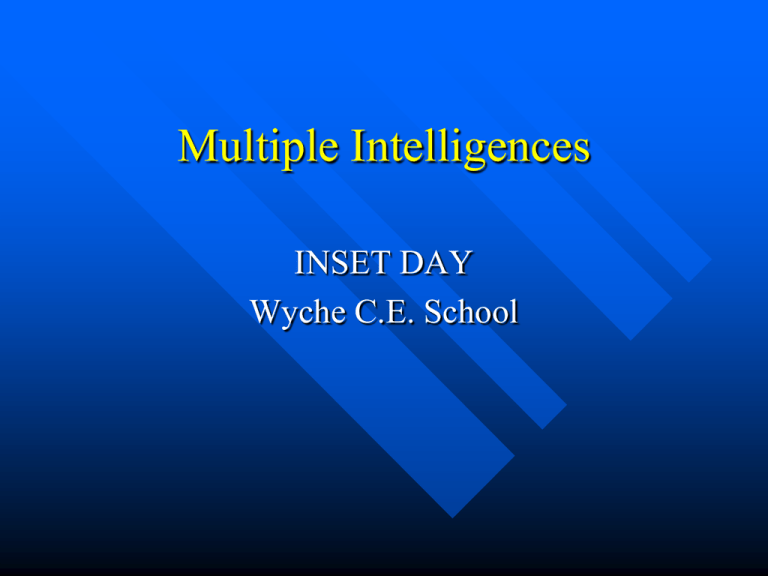
Multiple Intelligences INSET DAY Wyche C.E. School Section 1: What is Intelligence? What is intelligence? Intelligence is …. “ the capacity to act purposefully thinking rationally and deal effectively with the environment” David Wechsler (inventor of Wechsler adult intelligence scale) What is intelligence? “An intelligence is the ability to solve problems, or to create products, that are valued within one or more cultural settings” Howard Gardner (1989) What is intelligence? “Intelligence is the capacity to do something useful in the society in which we live. Intelligence is the ability to respond successfully to new situations and the capacity to learn from one’s past experiences.” Dr. Howard Gardner, author, Frames of Mind and Multiple Intelligences: The Theory in Practice What is intelligence? The Question isn’t “How intelligent is the child?” But “In what ways is the child intelligent?” Trevor Hawes Effective Teaching and Learning What is intelligence? “It’s not how smart you are it’s how you are smart” H. Gardner “Common miracles”1993 What is intelligence? "How would the proverbial Martian landing on Earth view the intelligence of the human species?" Harvard professor of education, Howard Gardner. What is intelligence? Both Tom Cruise and Robbie Williams both were voted “the child most likely to succeed in life” by their classmates What were the criteria used? A story of intelligence? A belligerent Samurai once challenged a Zen master to explain the concept of Heaven and Hell. But the monk, replied with scorn saying “You’re nothing but a lout, I can’t waste my time with the likes of you.” His very honour attacked the Samurai flew into a rage and pulling his sword from it’s scabbard yelled, “I could kill you for your impertinence.” “That,” the monk calmly replied, “is Hell.” Startled at seeing the truth the master had pointed out about the fury that had him in its grip, the Samurai calmed down, sheathed his sword and bowed, thanking the monk for the insight. “And that,” the monk replied, “is Heaven.” Section 2: Intelligence A Recent Historical Perspective Traditional View “In my experience most people, both teachers and the general public, still hold the view that there is a single general intelligence (IQ) which children have to a greater or lesser extent and can be accurately measured on an intelligence test” Deborah Eyre Able Children in Ordinary schools (1997) Binet and Simon The founder of these traditional ideas was Alfred Binet (a Frenchman working in the early 20th cent) with his colleague Theodore Simon Binet’s work saw intelligence as hereditary and therefore unchanging Binet and Simon “IQ has been thought to be a fixed limit on an individual’s capacity to learn – which leads to being regarded as more or less able than their peers” Trevor Hawes Effective Teaching and Learning Binet and Simon If his premise is true one could devise a test that would definitively determine intelligence levels for life Binet used his tests to sift out retarded children and place children in appropriate grade levels Binet and Simon Binet’s work influenced government opinion and led to the 11+ selection system His work was later found to be fabricated He even made up his two assistants Binet and Simon Do we fall into this trap? “Oh yes he’s really intelligent” But what do we mean? Intelligent at what? In what context? Binet and Simon “The fact that such a view remains dominant is a legacy of the 1944 education act. This was firmly rooted in the view that intelligence was inherent and measurable and that these different levels of intelligence needed different types of education” Deborah Eyre Able Children in Ordinary schools Intelligence : Changing Views “The assumption that a high IQ is essential for outstanding achievement is giving way to recognition of the vital role of …. personal attributes such as motivation, self discipline, curiosity and a drive for autonomy” Freeman (1995) Intelligence : Piaget Piaget began work in the 1920’s in Simon’s laboratory He became concerned with the emphasis being placed on the answer and not on the processes children employed to get there Intelligence : Piaget His developmental theory is well known and has formed the basis for much recent educational thinking However his theory still concentrates on a Linguistic/Mathematical based model Intelligence : Sternberg 1. 2. 3. Sternberg was the first to develop a theory that broke away form the one cohesive intelligence model He developed a tripartite theory with three sub theories these included: Context Experience Information Processing Section 3: An Introduction to Multiple Intelligence The Views of Howard Gardner Gardener’s Premise Intelligence is not a single general capacity that each individual has to a greater or lesser extent of the mind Intelligence cannot be measured by simplistic pen and paper tests or their like Gardener’s Definition of Intelligence “An intelligence is the ability to solve problems or create products, that are valued within one or more cultural settings” Frames of Mind Introduction to second edition p14 Gardener March 1993 Western Cultural Values The Greeks valued Academia The ability to remember factual information and process it cognitively Emphasis on Numeracy and Literacy Western Cultural Values There is a distinction between the Academic and the Intelligent Academic relies on retention of information and applying it to academic contexts (e.g. writing articles) Intelligence is more broad and more nebulous to define Western Cultural Values Traditionally the education system has been weighted towards the latter Andy’s response to the question “What was that chemical?” He was able to outline its use and its name Historical Values In medieval times the core subjects in the curriculum were: Grammar, logic and rhetoric, Mathematics, Geometry, Astronomy and Music Frames of Mind Introduction to second edition p7 Gardener March 1993 The South American Tribe The skill that was prized was the ability to hunt the monkey 1.Accuracy with poisoned darts 2.General high levels of fitness and stamina Contextualisation of Intelligence Increasingly there is a trend within the behavioural sciences to cease seeing intelligence as an innate, fixed commodity but to determine a person’s intelligence in the light of the social context they find themselves in Contextualisation of Intelligence Hence: The skills needed in today’s society differ greatly from those in the post industrial revolution and will again differ from those required in the knowledge economy of the 21st Century Multiple Intelligences The first pages of Gardner’s book set out his desire to develop a theory of intelligences that crosses cultural and social boundaries 1. 2. 3. The Puluwat tribesman chosen to be a master sailor able to navigate around the islands by the stars The 15 year old Iranian student who has memorised the Koran by heart The 14 year old adolescent in Paris who has programmed the computer and is writing music with the aid of a synthesiser Who is more Intelligent? Who is more intelligent and how would we know? The Beckham and Einstein brain debate Much of it will be governed by what society deems to be intelligent behaviour Theories and Band Wagons There is little value in picking up and running with individual theories They need to dovetail into a wider educational philosophy Constructivist theory Section 3: The Seven Intelligences Howard Gardner Multiple Intelligences Multiple Intelligences Verbal/Linguistic - "Word Smart" Logical/Mathematical - "Math Smart" Musical/Rhythmic - "Music Smart" Bodily/Kinesthetic - "Body Smart" Visual/Spatial - "Art Smart" Interpersonal - "People Smart" Intrapersonal - "Self Smart" Naturalist - "Nature Smart" Existential - "Wondering Smart" Linguistic Intelligence Linguistic Intelligence Language consists of 1.Phonology 2.Syntax 3.Semantics 4.Pragmatics The first two are all about pure linguistic intelligence The latter have input from other sources of intelligence such as inter-personal, logical etc. Linguistic Intelligence Language is crucial that of the language area of the brain is destroyed the brain uses areas given over to spatial abilities The appreciation of shades of meaning Linguistic Intelligence It was only in the middle ages with the advent of the printing press that written language became important until then oral language was deemed a higher quality to attain Linguistic Intelligence Hence rhetoric is valued in leaders Public schools, African cultures today The great Greek debates and the emphasis on oratory as a key skill Linguistic Intelligence Today, has the internet made written communication more important Will the advent of video conferencing revert us back to verbal language as a core communication skill? Linguistic Intelligence Written Language is harder because a context for it needs to be supplied Verbal language has by definition a context and has the added dimension of gestures and facial expression Novels can be translated poems can’t Musical Intelligence Musical Intelligence To some the art of musical composing is something that flows naturally “It is something that the composer is born to do” Aaron Copland “I constantly hear tones in my head” Roger Sessions Musical Intelligence To some composing is as natural as: “Milk coming from a cow” (Wagner) “Apples coming from an apple tree” (SaintSaens) “It’s just easy” David Lowe Musical Intelligence 1. 2. Music is made up of two major components Pitch (or melody) Rhythm This may be horizontal ie. how the pitch alters over time Vertical where melody and rhythms combine at the same time Musical Intelligence “music occupies a relatively low niche in our culture, and so musical illiteracy is acceptable” Frames of Mind Introduction to second edition p7 Gardener March 1993 Mathematical/Logical Intelligence Mathematical/Logical Intelligence 1. 2. 3. 4. Mathematical intelligence fulfilled in various arenas Babylon: Astronomy Pythagoras: Universe and reason Renaissance: Nature’s secrets Kant: Rational Thinking Mathematical/Logical Intelligence Calculation in left brain Patterns and relationships in the right hand side The pursuing of Maths and Science as an end in itself is a Western ideal Mathematical/Logical Intelligence The autistic spectrum holds children who can tell you the day of the week for any date in the last 3 centuries But although using a mathematical concept there is no application Mathematical/Logical Intelligence Maths unlike all other intelligences is not auditory and oral but is concrete and established through the confronting of objects Mathematical/Logical Intelligence Maths is one of the few intelligence that can only be appreciated by those who have a similar ability. Loners and mathematicians? Not true of music, literacy, personal skills Spatial Intelligence Spatial Intelligence Fold a piece of paper and fold again and again. How many squares on the paper? Sometimes called visual-spatial Did you multiply 2x2x2? Spatial Intelligence The autistic child who can draw with great accuracy the Houses of Parliament with all detail having seen it once Leonardo Da Vinci who could suspend the flight of birds and draw them in pinpoint accuracy Spatial Intelligence The ultimate test is chess where players have to determine a series of moves ahead in their mind The blindfolded player who takes on three games “You play chess blindfolded anyway in the sense that the pieces restrict one’s ability to work out further moves” Spatial Intelligence The intelligence with the greatest gender difference Men in the western world outscore women considerably in this area Spatial Intelligence The Eskimos have to remember the detail in each snow drift to determine their journey home There is no gender difference in Eskimo culture on spatial tests 60% of Eskimos score within the top 10% of westerners on spatial ability Bodily/Kinesthetic Intelligence Bodily/Kinesthetic Intelligence The Greeks held the body on a par with the body and the soul Roger Sperry “What use is intelligence if you cannot put it into action” My father and the pool table Bodily/Kinesthetic Intelligence Dance is culturally bonding eg the haka “If I could tell you what it is I would not have danced it” Isadora Duncan – famous dancer 20th century Interpersonal and Intrapersonal Intelligence Interpersonal and Intrapersonal The two intelligences reflect our ability to relate to others and ourselves Intrapersonal is how you understand yourself Interpersonal is how we relate to others Interpersonal and Intrapersonal These intelligences are strongly culturally based The interpersonal skills in cultures are rarely transferable Pubs and driving in Canada/soles of your feet in Thailand Interpersonal and Intrapersonal Society set the code and the framework for these intelligences A child picks up approval and/or disapproval for actions from its own society The key attribute is the ability to adapt to circumstances Interpersonal and Intrapersonal The two intelligences are physiologically separate. Lesions in the brain have demonstrated that in some cases one loses an ability to care for self whilst other brain damage causes one to lack empathy and aggressive and temperamental behaviour towards others Interpersonal and Intrapersonal Tim and the living proof of interpersonal and intrapersonal skills as a separate intelligence Brain damage can take away aspects of personality as readily as areas of a person’s intellect Interpersonal and Intrapersonal Cultures place varying emphasis on these two areas The Eastern ideal is to merge your personality with the culture around you The West values the eccentric, the entrepreneur and individual flair The Dumbed Down Version Mathematical - Carol Vordeman Linguistic - Shakespeare Musical - Mozart Interpersonal - Princess Diana Intrapersonal - Ghandi Bodily Kinaesthetic - David Beckham Spatial – Leonardo Da Vinci Naturalist - Charlie Dimmock The Multi-Intelligence Man Leonardo Da Vinci excelled in Maths, linguistic, logical analytical, art, sculpture Section 5: An Assessment framework for the Multiple Intelligence Theory Gardener’s Admission of his own Definition “… a definition that says nothing about either the sources of these abilities or the proper means of testing them” Frames of Mind Introduction to second edition p14 Gardener March 1993 Clarification of the theory After developing the theory Gardner looked towards assessing these intelligences His first thought was to assess them in “pure” form ending up with a seven-pronged intelligence profile Clarification of the theory na l tr ap er so na l In In te rp er so us ic al M ae st he t ic pa tia l S ng ui Li K in M at he m at ic al st ic Multiple Intelligences A traditional Multiple Intelligence profile Test your own MI There have been a raft of test materials for teachers and staff to assess their own and their pupil’s multiple intelligence profile Use this website address to test your own MI http://www.thethinkingclassroom.co.uk/mionline .htm http://www.surfaquarium.com/Miinvent.htm http://www.bass.gov.uk/MIprimary Clarification of the theory However children demonstrate each intelligence in a range of domains or tasks. e.g. Spatial intelligence may be expressed in a puzzle solution, route finding, block building, basketball passing Clarification of the theory Similarly adults do not exhibit their spatial intelligence directly They develop spatial skills that allow them to become proficient chess players, artists, geometricians or sportsmen. Section 6: Multiple Intelligences The Heavy Section!! Intelligences, Domains and Fields “The concept of intelligence constitutes a true scientific paradigm in the Kuhnian sense” (p15) Gardner came to see that his theory required further constructs when applied to assessment. Intelligences At the level of the individual it is right to speak about human intelligences Hence we might say “Mary has great musical intelligence” Domains Humans are born into cultures and these have domains built into them. These are disciplines, crafts and other pursuits that any given culture values. Intelligences and Domains Although there is a strong relation between intelligence and domains they must remain distinct in character A musical performance needs intelligences beyond musical (bodily-kinaesthetic, personal) Similarly music intelligence can be displayed in areas above and beyond music (dance, advertising) Fields The field is a sociological construct and includes the people, institutions, award mechanisms that render judgements upon performance. This is the sharp end of where multiple intelligences are assessed. It is a judgement by any given society on what it values and esteems within an individual’s intelligence make up Fields The fields allow the extent to which one is deemed competent in a given area It will assess a combination of one’s natural intelligence, its use in a range of domains and relate performance to a given end criteria Football as an Intelligence! The Intelligence Used: Bodily Kinaesthetic Intelligence The Domain: F.A. coaching/ playing award The Field: Playing for Manchester United A word of Caution “to fall into the habit of saying that we here behold the linguistic intelligence or the spatial intelligence…these intelligences are fictions - at most useful fictions – for discussing processes and abilities that (like all of life) are continuous with one another. They exist not as physically verifiable entities but only as potentially useful scientific constructs” p69-70 Section 7: Multiple Intelligences Practical Implications for Classteachers Gardener’s Own Viewpoint Gardner has not stated the practical implications of his theory for classroom but let teachers apply it for themselves Neither does he as a matter of principle endorse commercially related products Gardener’s Own Viewpoint “Multiple Intelligences (MI) is a tool. It’s not a goal. That means teachers have to decide what to teach and that should be based on what they think is important” Howard Gardner Interview with NEA Today The Key School However he has worked closely with the Key School, now called the Key Learning Community A pioneering school for MI in the curriculum See their website Possible Ways Forward To make sure every lesson has an aspect that covers each of the multiple intelligences Make sure it covers VAK learning Is fully differentiated for all children All pigs ready to fly! However what we could do… “Estimates suggest that 70% of the National Curriculum is geared towards just two intelligences” Trevor Hawes Effective Teaching and Learning However what we could do… “Teaching through the 7 intelligences expands the opportunities for all pupils to construct their own meaning in the way most appropriate to them ” Trevor Hawes Effective Teaching and Learning The Vikings If a key to history is to use secondary sources do those sources have to be written? Viking Music Viking Artefacts Viking Art Viking Raiding Maps The Vikings One way many schools apply the theory is through what they call “Self directed learning” (child driven learning) Children use personal strengths to take on board new concepts The Vikings If a key historical question is “Why did the Vikings leave Scandinavia?” They can acquire the history concept through any or all of Gardner’s Intelligences There may be an issue of defensive timetabling Final Thoughts Theories and Band Wagons There is little value in picking up and running with individual theories They need to dovetail into a wider educational philosophy Constructivist theory
